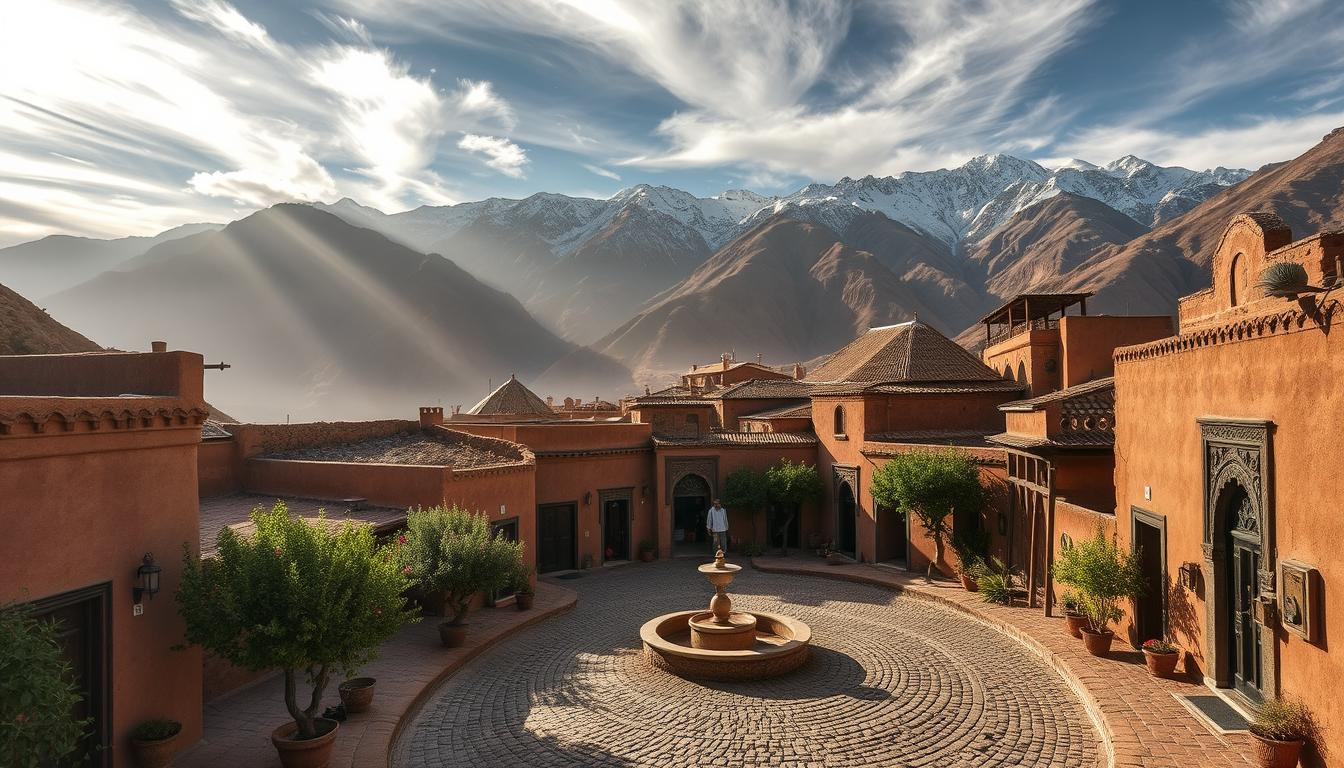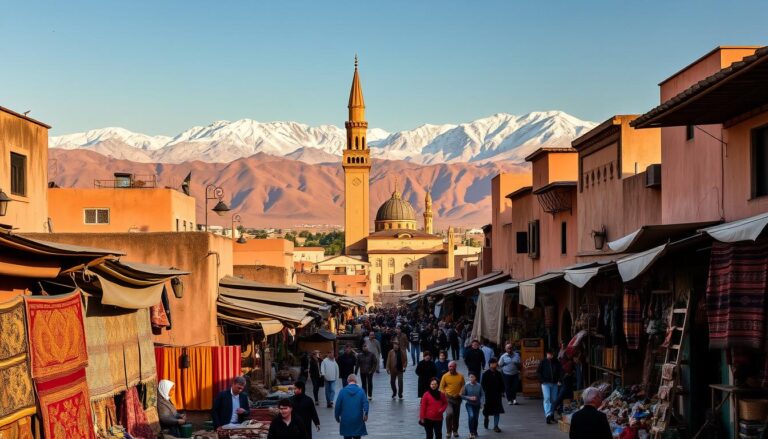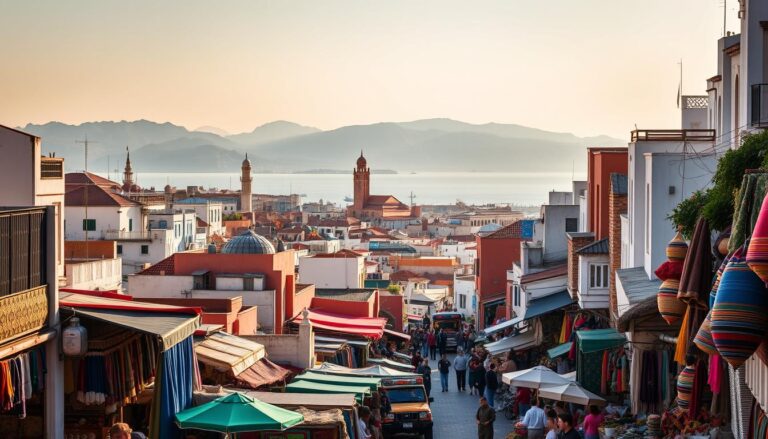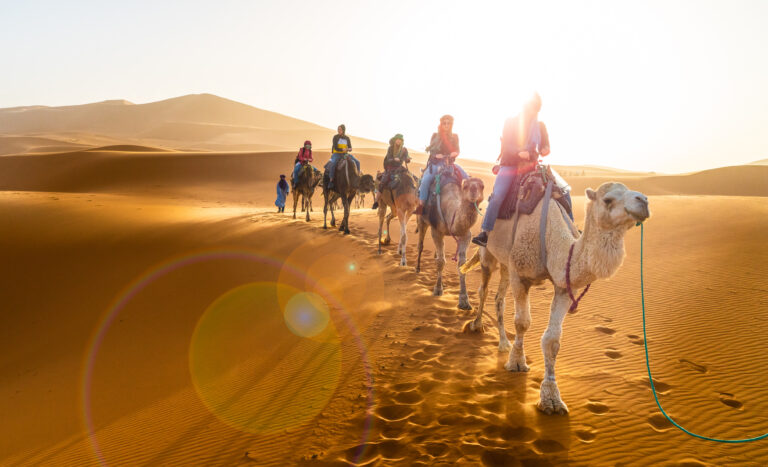Imlil Travel Guide: Gateway to the High Atlas Mountains
Table of Contents
Imlil Travel Guide: Gateway to the High Atlas Mountains
Did you know Morocco’s High Atlas Mountains attract over 30,000 adventurers annually, many starting their journeys from a single village? Nestled at 1,800 meters above sea level, this rugged escape offers more than just cooler air—it’s your doorway to North Africa’s highest peak, Jebel Toubkal.
Just 60km south of Marrakech, the drive here winds through terraced hillsides and Berber hamlets. You’ll watch arid plains transform into snow-dusted peaks within 90 minutes. At road’s end, crisp mountain breezes replace desert heat, welcoming you to a world of walnut groves and stone-built guesthouses.
The village’s elevation makes it ideal for acclimatizing before tackling Toubkal’s 4,167-meter summit. But you don’t need to be a mountaineer—gentle trails reveal waterfalls, apricot orchards, and panoramic vistas. Local guides share generations of knowledge, helping you navigate ancient trade routes now used for trekking.
Key Takeaways
- Reach North Africa’s highest peak from a village just 1.5 hours from Marrakech
- Escape desert heat at 1,800 meters with fresh mountain air and stunning vistas
- Discover Morocco’s premier trekking hub with trails for all skill levels
- Experience authentic Berber culture through homestays and local cuisine
- Use strategic location to explore Toubkal National Park’s diverse ecosystems
Exploring Imlil and Its Surroundings
This mountain hub wasn’t always Morocco’s trekking capital. The village you see today grew from a strategic decision to welcome adventurers while preserving ancient ways of life in nearby valleys.
Roots and Reinvention
Before trekking became popular, locals thrived on walnut orchards and cherry harvests. Traditional stone homes still dot the hillsides in settlements like Tamatert and Ait Souka, where Berber families maintain centuries-old customs. The main road connecting these communities now brings travelers instead of traders.
Seasonal shifts shape daily life here. Spring meltwater turns the Asif N’au Mizane river into a roaring force, while autumn reveals calm streams beneath golden walnut leaves. Nature’s power struck tragically in 1995 when floods reshaped the valley, but rebuilt guesthouses and trails now showcase local resilience.
Balancing Past and Progress
Guides who once farmed apples now lead hikes through terraced slopes. You’ll find authentic culture in valley homestays, where shared mint tea moments reveal stories of adaptation. Tourism income supports walnut harvests, creating a unique blend of old and new economies.
The village’s evolution offers a blueprint for sustainable mountain travel. As you walk between ancient hamlets and modern cafes, you’re tracing a living map of cultural preservation meeting opportunity.
Trekking and Outdoor Adventures in the Atlas Mountains
Your boots crunch on gravel paths as morning light paints North Africa’s highest peak in gold. This rugged playground offers more than summit glory—it’s where ancient trails meet modern adventure.
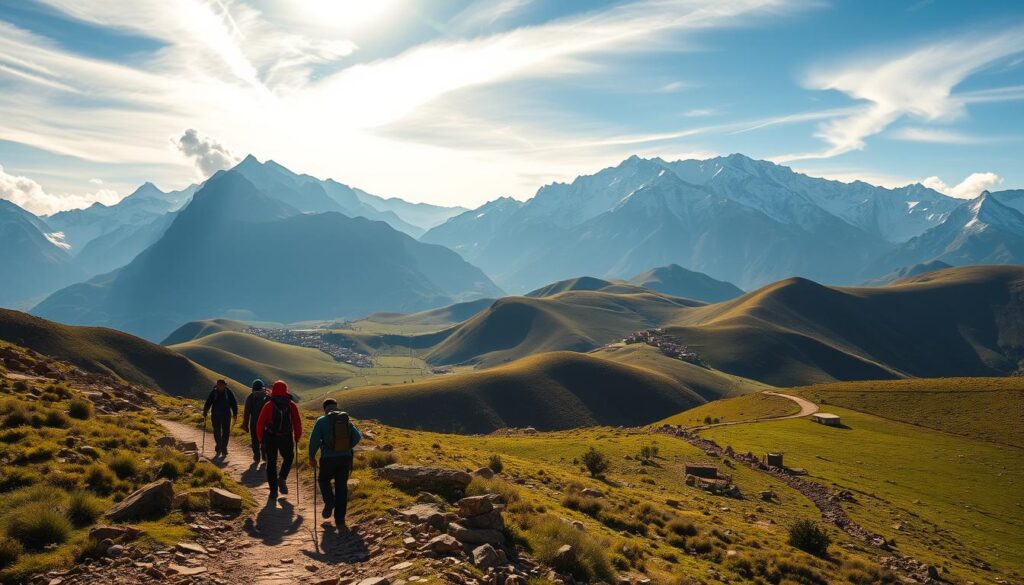
Hiking Trails and Routes to Jebel Toubkal
Nine out of ten explorers begin their ascent here, aiming for Jebel Toubkal’s 4,167-meter crown. The classic two-day route winds past walnut groves into raw wilderness. You’ll spot seasonal juice stands near crumbling shepherd huts—perfect pit stops before steep climbs.
The trail reveals surprises at every turn. Sacred Sidi Chamharouch village appears like a mirage, its whitewashed shrine glowing against red cliffs. Higher up, two mountain refuges buzz with international trekkers swapping stories. Book beds early June-August when dorm rooms fill faster than melting snow.
Guided Treks, Mules, and Essential Gear
Local guides transform hikes into cultural exchanges. “Our mules carried tea caravans before backpacks,” laughs Mohamed, a third-generation mountain expert. These sturdy animals still haul 220-pound loads up rocky paths, letting you savor views stress-free.
Rent crampons for winter ascents when snow transforms the Atlas Mountains into a skier’s paradise. Gear shops stock everything from headlamps to honey-drenched energy bars. Leave heavy tents behind—mountain huts provide blankets and steaming tajines after star-filled nights.
Accommodations, Cuisine, and Local Experiences
Mornings here begin with the scent of walnut wood smoke curling past your window. This mountain town offers more than trailheads – it’s where Berber hospitality meets rugged charm.
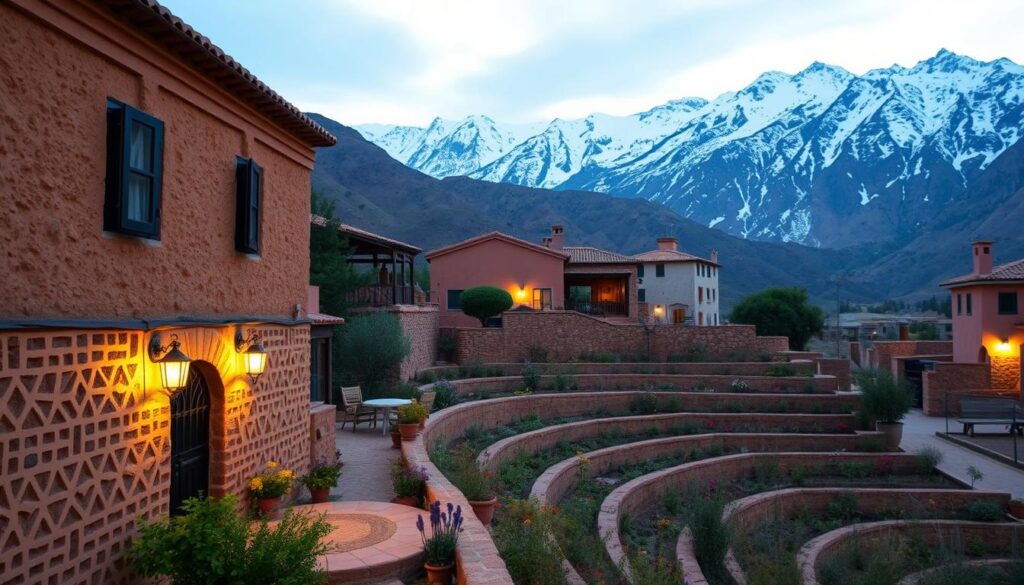
Sleeping Among Peaks
Choose your mountain nest wisely. Traditional riads wrap you in geometric tilework and carved cedar ceilings. For jaw-dropping views, Riad Atlas Panorama crowns the village with 360-degree panoramas. Prefer legend status? The Kasbah du Toubkal serves mint tea on a terrace overlooking terraced orchards.
| Feature | Riads | Kasbahs |
|---|---|---|
| Architecture | Intimate courtyards | Fortified elegance |
| Views | Valley glimpses | Summit panoramas |
| Dining | Family-style meals | Gourmet tajines |
Taste the Valley
Local chefs transform mountain harvests into magic. At Chez les Berbères, walnut-stuffed lamb melts off the bone. Zaratoustra Auberge’s rooftop turns sunset into dinner theater – sip saffron tea as shadows climb Jebel Toubkal.
“Our apples taste sweeter because they dance with altitude,” says Fatima, a third-generation orchard keeper. Her family’s cherries star in jams served at Kasbah du Toubkal Restaurant. Don’t miss Friday market days when villagers trade honey-drenched pastries.
Whether you bunk in a budget guesthouse or splurge on kasbah luxury, each night here deepens your mountain connection. Morning treks taste better after evenings filled with starry skies and shared tagines.
Conclusion
Reaching this High Atlas hub feels like discovering Morocco’s best-kept secret. Winding mountain roads connect you to Asni’s Saturday markets and Marrakech’s airport – a 90-minute shared taxi ride costing less than $4. Private transfers offer comfort for those craving door-to-door service.
The village’s Hollywood moment in Seven Years in Tibet proves its cinematic appeal. But the real magic lies in daily life here. You fuel sustainable tourism simply by sipping mint tea at family-run guesthouses or hiring local guides.
With Jebel Toubkal’s summit visible from every trail, the Atlas Mountains deliver adventures for all. Trekking routes range from gentle valley walks to ice-axe challenges. Each visitor helps preserve traditions while supporting new opportunities in these rugged peaks.
Your journey matters beyond personal discovery. Choosing homestays over hotels keeps ancient customs alive. Opting for guided hikes sustains mountain communities. Every dirham spent here writes the next chapter in Morocco’s High Atlas story – one where cultural heritage and responsible travel thrive together.

